Wisper
Site Staff  Boss Lady
Whimsical in the Brainpan
Boss Lady
Whimsical in the Brainpan
Posts: 341 
|
Post by Wisper on Apr 6, 2012 15:26:32 GMT -7
First you should know that you aren't limited to just the ships posted in this topic. Feel free to create you own or find a ship design elsewhere. Just make sure there is an image for the ship as well as a basic deckplan so other players have an idea about the ship's appearance and layout. Please take note that some ships are military only. Click on deck layouts for a bigger view. an encore for creditsLayout used for the ship stats below was made by Amanda the Pirate * at Caution 2.0
[center][font=georgia][i][size=8][color=6D92B5][b]Name[/b][/color][/size][/i][/font]
[url=][IMG][/IMG][/url][url=][IMG][/IMG][/url]
[font=terminal][color=4E4E4E][blockquote][blockquote]
INFO
[/color][/FONT][/blockquote][/blockquote]
[img][/img][/center]
|
|
Kitten
Inactive  Wielder of Applejack
Wielder of Applejack
Posts: 64
|
Post by Kitten on Apr 7, 2012 12:26:45 GMT -7
Aces and Eights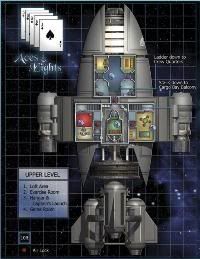  Ship length: 191 feet
Ship width: 125 feet
Ship height: 65 feet
2 Double passanger dorms
2 Single passanger dorms
2 Double passanger dorms (bunk beds)
2 Single passnager dorms
|
|
Kitten
Inactive  Wielder of Applejack
Wielder of Applejack
Posts: 64
|
Post by Kitten on Apr 7, 2012 12:27:08 GMT -7
Alliance Patrol Boat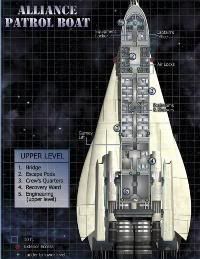 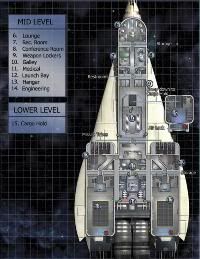
Tonnage: 390 tons
Speed Class: 6 cruise/ 10 Hard Burn Crew: 2
Fuel Capacity: 8 tons (600 Hours)
Cargo Capacity: 50 tons
Passengers: 2 (in brig)
Crew: 42 Crew beds
Price: 40,000 new Maintenance
Cost: 1248 credits per year
Armaments Nosegun .2-lb autocannon 2000 round magazine
Missile Load: 20 tons
|
|
|
|
Kitten
Inactive  Wielder of Applejack
Wielder of Applejack
Posts: 64
|
Post by Kitten on Apr 7, 2012 12:27:35 GMT -7
Basurero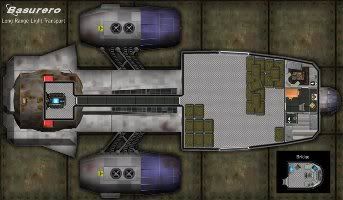
Crew: 2-3
|
|
Kitten
Inactive  Wielder of Applejack
Wielder of Applejack
Posts: 64
|
Post by Kitten on Apr 7, 2012 12:27:47 GMT -7
Bumblebee
3 Single Dorms
1 Double Dorm
|
|
Kitten
Inactive  Wielder of Applejack
Wielder of Applejack
Posts: 64
|
Post by Kitten on Apr 7, 2012 12:28:00 GMT -7
Caravel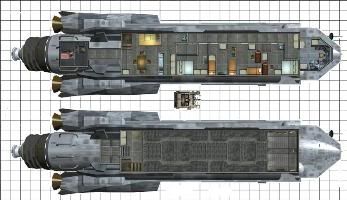
3 Single dorms
2 Double dorms
|
|
Kitten
Inactive  Wielder of Applejack
Wielder of Applejack
Posts: 64
|
Post by Kitten on Apr 7, 2012 12:28:20 GMT -7
Dragonfly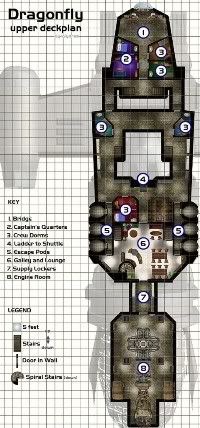 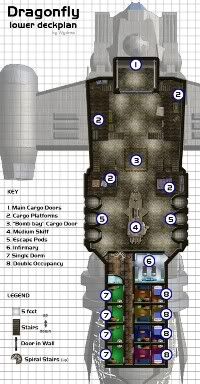
Crew Quarters: 3 singles, 2 double (Captain's is a double)
Passengers: 4 singles, 4 doubles
Escape Pods: up to 2 people per pod, 12 pods
|
|
Kitten
Inactive  Wielder of Applejack
Wielder of Applejack
Posts: 64
|
Post by Kitten on Apr 7, 2012 12:28:31 GMT -7
Drakken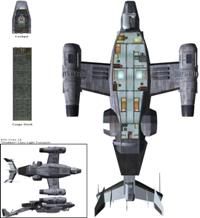
3 Single dorms
2 Double dorms
|
|
Kitten
Inactive  Wielder of Applejack
Wielder of Applejack
Posts: 64
|
Post by Kitten on Apr 7, 2012 12:28:44 GMT -7
El Dorado 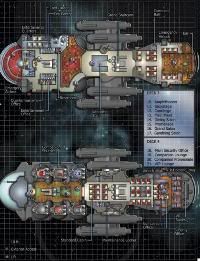 
Type: Cruise liner
Ship length: 397 feet
Ship width: 160 feet
Ship height: 52 feet
Maximum payload: 800 tons
Fuel capacity: 600 tons (1,200 hours)
Crew capacity: 8 officers
16 hands
50 crew dedicated to passenger care
10 entertainers
Passenger capacity: 43 double cabins
3 VIP suites
Carried vessels: 6 20-ton passenger shuttles
16 20-ton life boats
Deck 1
Deck 1 was the lowest level of the ship and contained the vessel's power converters and engine room towards the aft, as well as other ship systems such as the landing gear, air locks, and exterior docking ring. Deck 1 was also the location of the ship's two cargo bays at the fore of the ship, as well as crew quarters and bathrooms in the middle. A guest gangway, which allowed passengers access to the ship when it was landed on a planet, led to a reception area where guests were received before being taken to quarters on the upper levels. A small security post was also located near to the reception.
Deck 2
Deck 2 was reserved for crew members. Crew quarters were located to the aft of the deck, along with the crew lounge and crew mess. A pantry, larder and kitchen were located next to the crew mess, and the deck was also the site of the ship's laundry and the purser's office. A reception area for guests transiting through the deck was located in the middle of the deck, while catwalks that were suspended above the cargo areas on Deck 1 dominated the fore of the ship.
Deck 3
Deck 3 was one of the passenger decks on a Floating World Class vessel. The forward section of the deck contained an theater with seating for up to five hundred people, as well as a full-depth stage that was able to put on a large variety of entertainment. A small backstage area and concierge station served the theater. Quarters for the entertainers were located near to the theater, which included bathrooms and a private mess complete with pantry and larder.
Public restrooms were situated near the theater, along with offices for both the quartermaster and entertainment officer. The main dining salon was located on this deck, along with a small promenade. The grand salon was in the middle of the deck, along with the start of the Grand Staircase, which ran from Deck 3 up to Deck 5. The aft of the vessel contained passenger cabins and restrooms, as well as the gambling salon and bar.
Deck 4
Deck 4 was another passenger deck. The forward section contained an area exclusively for Companion services, including a companion lounge and promenade, as well as access to the six passenger shuttles that were used by Companions to conduct their business in. The main security office was located on the companion promenade. The aft of the deck was reserved for passenger cabins and VIP suites. A secondary security office and a Companion office were located in the aft section.
Deck 5
Deck 5 was the operations deck of the vessel. The forward part of the vessel contained the cabins for both the captain and pilot, along with a conference room for staff meetings. The fore boat deck, which allowed access to eight of the ship's life boats, dominated the front of the vessel. The ship's bridge sat in the center of the deck. Behind the bridge was the top level of the Grand Staircase, which gave passengers access to the aft boat deck containing access to the other eight life boats and the ship's infirmary.
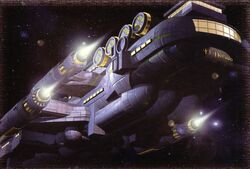 |
|
Kitten
Inactive  Wielder of Applejack
Wielder of Applejack
Posts: 64
|
Post by Kitten on Apr 7, 2012 12:29:00 GMT -7
Firefly Series 1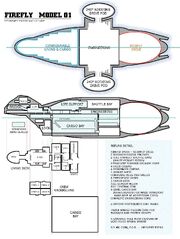
The original Firefly series was approved for production in June 2434, with the first boats being completed in February 2435. Unlike later designs, the Series 1 did not have a modular cargo area, a secondary cargo area, or passenger berths. The design can dock a pair of optional two-man shuttles known as "Beetles" on the dorsal neck (above the crew quarters). These small craft have no dedicated cargo area, with the passenger sitting behind the one-man cockpit.
8,000 Series 1 boats were sold over the next twelve years before production was halted to make way for the Series 2 design.
Firefly Series 2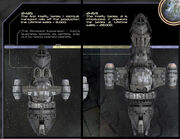
The Firefly Series 2 was approved for production in March 2447, with the first boats available for sale in 2448. The Series 2 was larger and more streamlined than the Series 1, adding a secondary cargo area (aft of the main cargo section) which could be outfitted with passenger berths.
The Series 2 also replaced the bulky engines used on the Series 1 with the all new Capissen 38 Mark II. The Capissen engines were a significant improvement in performance doubling the ship's top speed, while at the same time halving fuel consumption. Unfortunately, the new design was also more complicated and temperamental, leading to a notably higher failure rate over time. Despite the reliability issues, if properly maintained, the ship is amazingly maneuverable, and can still be found on the stunt circuit.
Only 5,000 Series 2 boats were sold, before production was halted to make way for the Series 3 design.
Firefly Series 3 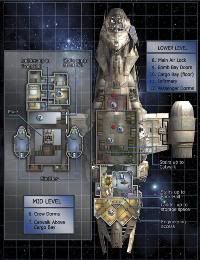
The Firefly Series 3 was produced in multiple versions. The standard version was the 03-K64-Firefly produced for the civilian market. A Military Version with multiple gun emplacements and wing mounted missiles was approved for production in August 2463.
The Series 3 featured a number of improvements over the earlier models, notably the extenders below the wings of the ship to stabilize the rotating VTOL engines, and hold them further from the main body of the craft (which keeps the ship from shaking as much as previous series, and allowed for shuttle bays to be built into the sides above the wings). Also, the Series 3 is longer, with an extended "neck", and generally roomier interior. It again uses the more reliable Trace Compression Block engine, rather than the Gurstler engine used in some other designs.
No longer in production, 28,000 Series 3 boats were sold over the designs production lifetime.
 Firefly Series 4
Type:Mid-bulk transport (Class A)
Drive: Enhanced graviton accelerator core
Powerplant: 4 Blue Sun EVT29-4000-A90 pulse-feedback generators, 48 RCS thrusters
Maximum payload: 325,000 lbs
Crew capacity: 15 (8 cabins, 1 dorm)
Passenger capacity: 36 (6 staterooms, 12 berths)
Acceleration: 5.5 G
Range: 750 A.U. (max fuel), 120 A.U. (max. payload)
Carried vessels: 2 Endo/Exo-Atmospheric Shuttles, 10 Emergency life pods, 2 MF-950 Flying Mules (extended cab)
Other equipment: 4 Magnetic grappler launchers, 10 Self-powered transmitter buoys
The Firefly Series 4 was approved for production in January 2513, with availability projected for July 16, 2513. The Series 4 is 25% faster than the Series 3, and has twice the range. The main hull is significantly wider than a Series 3, with two side-by-side main cargo bays in the main section. Aft of this section the secondary cargo area is also larger accommodating proper passenger staterooms, or a larger number of berths. The boat also has room for twice the crew of a Series 3.
The larger amount of crew space has allowed for the addition of a dedicated land vehicle bay, a cargo elevator, and a small hydroponics garden. The main cargo section is modular, and can be adapted to pick up and drop off standard cargo modules without anyone entering the cargo bay itself.
With the increased size and capability comes a higher price tag, primarily for operating expenses. The increased cargo / passenger area is necessary to take jobs to maintain upkeep on a Series 4. This type is primarily used on the lucrative routes between the Core and the Border. For captains traveling the Rim and more interested in economy of operation, the Series 3 remains the better option.
|
|
Kitten
Inactive  Wielder of Applejack
Wielder of Applejack
Posts: 64
|
Post by Kitten on Apr 7, 2012 12:29:13 GMT -7
Hornet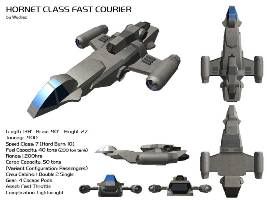 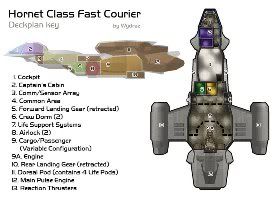
Captain's Dorm (Double Bed)
2 Crew Dorms (Two single beds per room)
|
|
Kitten
Inactive  Wielder of Applejack
Wielder of Applejack
Posts: 64
|
Post by Kitten on Apr 7, 2012 12:30:33 GMT -7
OddEasy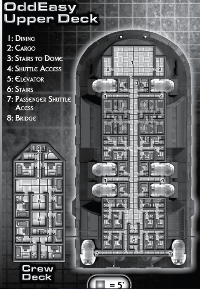 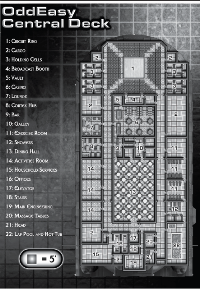 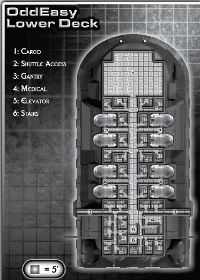
Tonnage 8,525 tons, Speed Class 3 cruise/5 hard-burn, Crew 4 officers, 12 spacers, 20 service crew, 20
croupiers, 20 keepers, Crew Quarters 37 double cabins, two single cabins, Fuel Capacity 341 tons [1,200
hours], Cargo Capacity 400 tons, Passenger Capacity 20 double cabins, 20 holding cells, 4 VIP suites,
Armament:
A hidden pop-up turret with 10 short-range 50-pound missiles
Gear:
14 Standard 20-ton shuttles, Infirmary, casino and full Cortex broadcast facilities.
|
|
Kitten
Inactive  Wielder of Applejack
Wielder of Applejack
Posts: 64
|
Post by Kitten on Apr 7, 2012 12:31:01 GMT -7
Pride Class 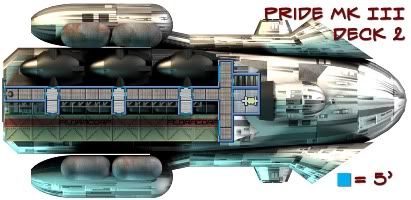
6 Single Bed Dorms Double Occupancy (Two beds or bunk beds)
6 Single Bed Dorms |
|
Kitten
Inactive  Wielder of Applejack
Wielder of Applejack
Posts: 64
|
Post by Kitten on Apr 7, 2012 12:31:23 GMT -7
Longbow-class Patrol Cruiser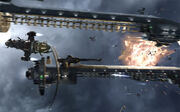 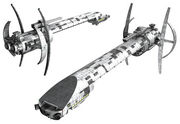
The Longbow-class Patrol Cruiser was a class of ship that was used in the Union of Allied Planets Navy. The Union of Allied Planets often deployed Longbow cruisers when it had to maintain a military presence but did not want to dedicate a massive Tohoku-class cruiser. Displacing 640,000 tons, the Longbow was more than enough to over-awe the average pirate squadron or planetary militia. The Longbow was still deceptively well armed, however, and packed a pair of heavy cannons, a dozen point-defense guns, 360 missiles and over a thousand jammer/decoys into the narrow hull. This was supported by more than fifty small craft and room for over 3000 troops, making it a very flexible vessel well suited for space superiority, interdiction, piracy suppression, and ground assault missions. Even with this impressive firepower, Longbows were rarely deployed alone and were usually grouped with smaller support vessels.
This ship also appealed to the civilian market, typically as a high-capacity freighter due to its robust design and long range. Stripped of weapons and magazine space, it could carry an impressive amount of cargo. Since the ship could not land, some of the hangar's spaces were retained for cargo shuttles. The civilian ship could be distinguished from the military cruiser by the bow-mounted fins, the curved, drooping bow extension and the lack of the large dorsal weapon mount.
|
|